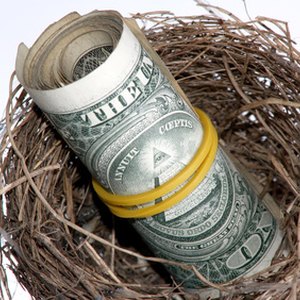
Interest paid on U.S. corporate loans called bonds averaged about 7 percent per year from 1990 through 2009, according to Standish Mellon Advisors. Interest rates throughout the yield curve -- from maturities of one month to 30 years -- have declined for approximately 30 years. In August 2010, Bloomberg reported that corporate bond interest coupons declined to historic low rates. For example, IBM sold three-year notes yielding only 1 percent.
Internal Revenue Service Data
IRS measures corporate bond returns on a monthly basis. At year-end 2010, IRS reports a 6.14 percent average weighted corporate bond interest rate. The range of corporate bond interest rates fall between 5.52 and 6.14 percent. The composite corporate bond interest rate has declined from a high range of 5.77 to 6.42 percent in January 2010. March 2009 offered high composite rates of over 7 percent. Corporate bond yields continued to fall through that year. Comparatively, composite rates of almost 8 percent were reported in Q4 2008. Corporate bond rates were higher than 2008's yields from 2003 to 2007. The previous low average bond yield ranged from 5.24 percent in 2003 to 5.84 percent in 2007. Similarly, Moody's Investors Service reports that Aaa-rated bonds returned approximately 6 percent from 2002 through 2010.
Disinflation Environment
According to Paul Krugman of "The New York Times," in 2010, the San Francisco Federal Reserve Bank confirmed that the United States' bond market continues to respond to disinflation pressures. Disinflation, unlike deflation, means that prices of goods and services are increasing at a slower than historical rate. Both disinflation and deflation environments cause bond prices to rise. In 1980, portfolio strategist Marshall Acuff explained the benefits of disinflation in the bond market. Investment grade (rated A or better) long-term corporate bond yields averaged more than 14 percent in 1980, according to authors Sidney Homer and Eugene Sylla in "A History of Interest Rates." Long-term bond yields average approximately 5 percent at year-end 2010, according to the Federal Reserve Board. Long-term interest rates on investment grade corporate bonds have declined by almost 65 percent during the period.
Corporate Bond Issuers and Credit Quality
Corporate bond issuers price coupon interest according to the current yield curve. That is, interest rates, corporate issuer credit quality, and market supply and demand for the issuer's bonds determine how much the issuer pays for a loan from bondholders. Credit rating agencies, including Standard & Poor's and Moody's, rate the issuer's creditworthiness. Only four corporate bond issuers receive an AAA rating -- the highest investment grade quality -- in 2010. Bloomberg reported an interesting phenomena in March 2010. Berkshire Hathaway's (rated AA+ by Standard & Poor's) 1.4 percent notes maturing in February 2012 yielded 0.89 percent. U.S. Treasury notes yielded 0.855 percent over the same term.
Lower Credit Quality Corporate Bonds
High-yield or junk bonds must pay higher coupon rates to attract lenders, according to The Securities Industry & Financial Markets Association, called SIFMA. Lenders bear a higher risk of default. For that reason, some stock investors purchase high-yield bonds.
References
- Bloomberg: Corporate Bond Coupons Decline to Record Lows With Sales From IBM, Expedia
- "The New York Times": Disinflation Confirmed; Paul Krugman; Dec. 5, 2010
- "The New York Times": IMarket Place; Investing Now For a Recession
- "A History of Interest Rates"; Sidney Homer, Richard Eugene Sylla; 2005
- U.S. Securities & Exchange Commission. "Investment-grade Bond (or High-grade Bond)." Accessed April 28, 2020.
- U.S. Securities & Exchange Commission. "High-yield Bond (or Junk Bond)." Accessed April 28, 2020.
- Fidelity Investments. "Corporate Bonds." Accessed April 28, 2020.
Writer Bio
Laura Lemay started writing in 1996. She has published articles on Luxist, Paw Nation, StyleList, Gadling, Urlesque, Asylum, BloggingStocks and other websites. Lemay also worked at "Ladies Home Journal" and "Institutional Investor." She holds a Bachelor of Arts in English from Smith College and a Master of Arts in education from Virginia Tech.

